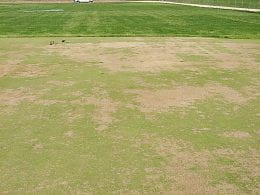By Cody Domenghini, Assistant Professor, Landscape Management
A mulch ring is a circular border surrounding a tree commonly made of organic material such as wood chips. Trees planted in turfgrass should have mulch rings installed around them for a couple of reasons. Creating a mulch boundary around trees prevents lawn maintenance equipment such as string trimmers and mowers from getting too close to the trunk and causing damage. When grass is allowed to grow right up to the trunk the tree roots are in competition with the turfgrass for water and nutrients. A mulch layer over the root zone eliminates this conflict.
Ideally, trees should be planted in a landscape bed rather than in the middle of a lawn. However, when grown in a lawn, trees should have a mulch ring at least three feet in diameter for every inch of tree trunk caliper surrounding them.

The mulch should resemble the shape of a donut with the center of the ring creating a 4-6” gap between the trunk of the tree and the start of the mulch. The space between the tree trunk and the mulch ring allows oxygen and water to easily reach the roots and prevents the risk of rot at the base of the trunk.


Avoid the common mistake of “volcano mulching”. Layer the mulch 2-4” deep. Throughout the year the mulch will breakdown, contributing organic matter to the soil and improving soil quality. Mulch should be reapplied annually. When adding a tree ring to an already established tree in a lawn, carefully remove the sod from the top few inches to not damage any tree roots.

Mulch rings for large trees should be large enough to create a barrier between the edge of the turfgrass and the trunk of the tree to prevent damage to the trunk from mowing equipment, but do not necessarily have to follow the size guidelines advised for younger trees. Adding tree rings and mulch around trees is best done in the spring, but can be completed anytime of the year.
Below is a link to an extension article discussing the proper way to mulch trees.
https://www.johnson.k-state.edu/lawn-garden/agent-articles/trees-shrubs/how-to-mulch-trees.html








